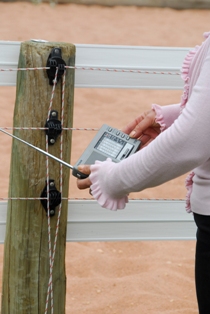A member recently contacted Farmstyle to tell us she had been visited by representatives from the Australian Communication and Media Authority in Canberra. The ACMA had received a complaint about television and radio interference and our reader’s electric fences were thought to be to blame.
The investigators found that faults in the fence circuits were causing the interference and an infringement notice was issued, as well as an order to correct the fault. Blake Murdoch from the ACMA explains how this occurs and how landholders can avoid this problem. |  |
Before building an electric fence, consider the following:
- The fence earth system must be away from the household supply, safety earth and buried water pipes.
- The fence earth must not connect to the mains supply safety earth or to the water supply pipes.
- The mains power supplying plugs and sockets for the energiser must be in good working order with no loose connections.
- The energiser earth cable must not touch buildings, which can act as a broadcast aerial. Use double insulated cable or run the wire to earth using insulators.
- Use only top quality insulators. Sparking inside cracked or poor quality insulators causes interference.
- Avoid running the electric fence line parallel to power or telephone lines.
- The energiser’s ground system should be at least 10m away from buried telephone wires.
Maintenance tips
Complete periodic visual inspections. Look for broken wires, cracked insulators, corroded hooks and overgrown vegetation touching the wires.
Clamp broken wires properly do not just hand twist. The same applies to any loose wires.
The Australian Communications and Media Authority (ACMA) may take regulatory actions under the Radiocommunications Act 1992 for causing substantial interference to radiocommunications including broadcast services. The ACMA encourages operators of electric fences to take voluntary measures to avoid and resolve interference from their electric fences without intervention of the ACMA.


